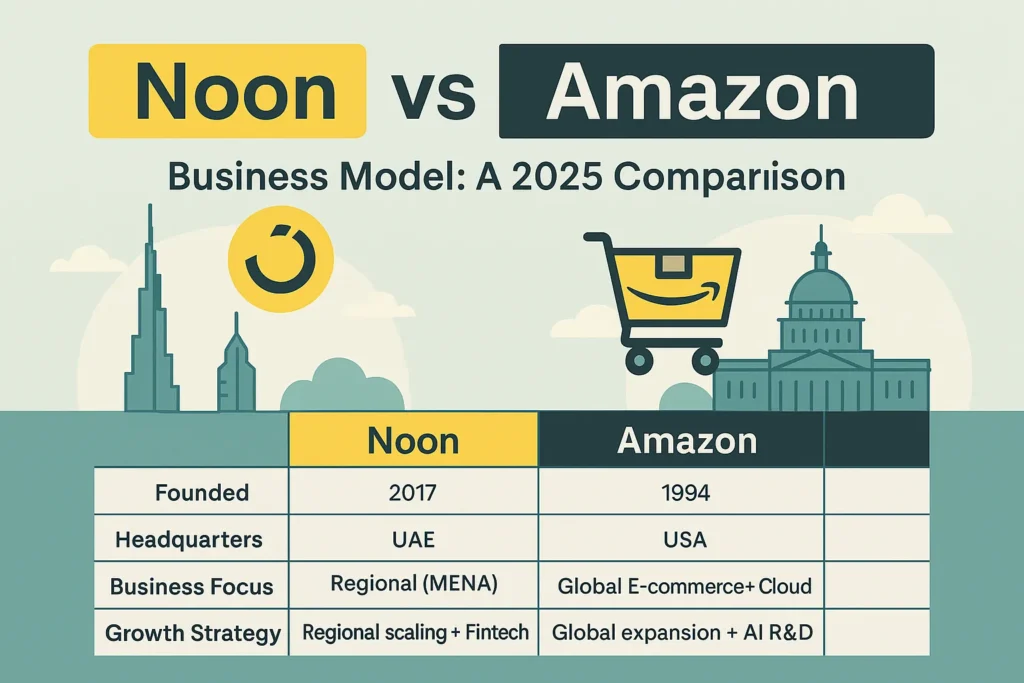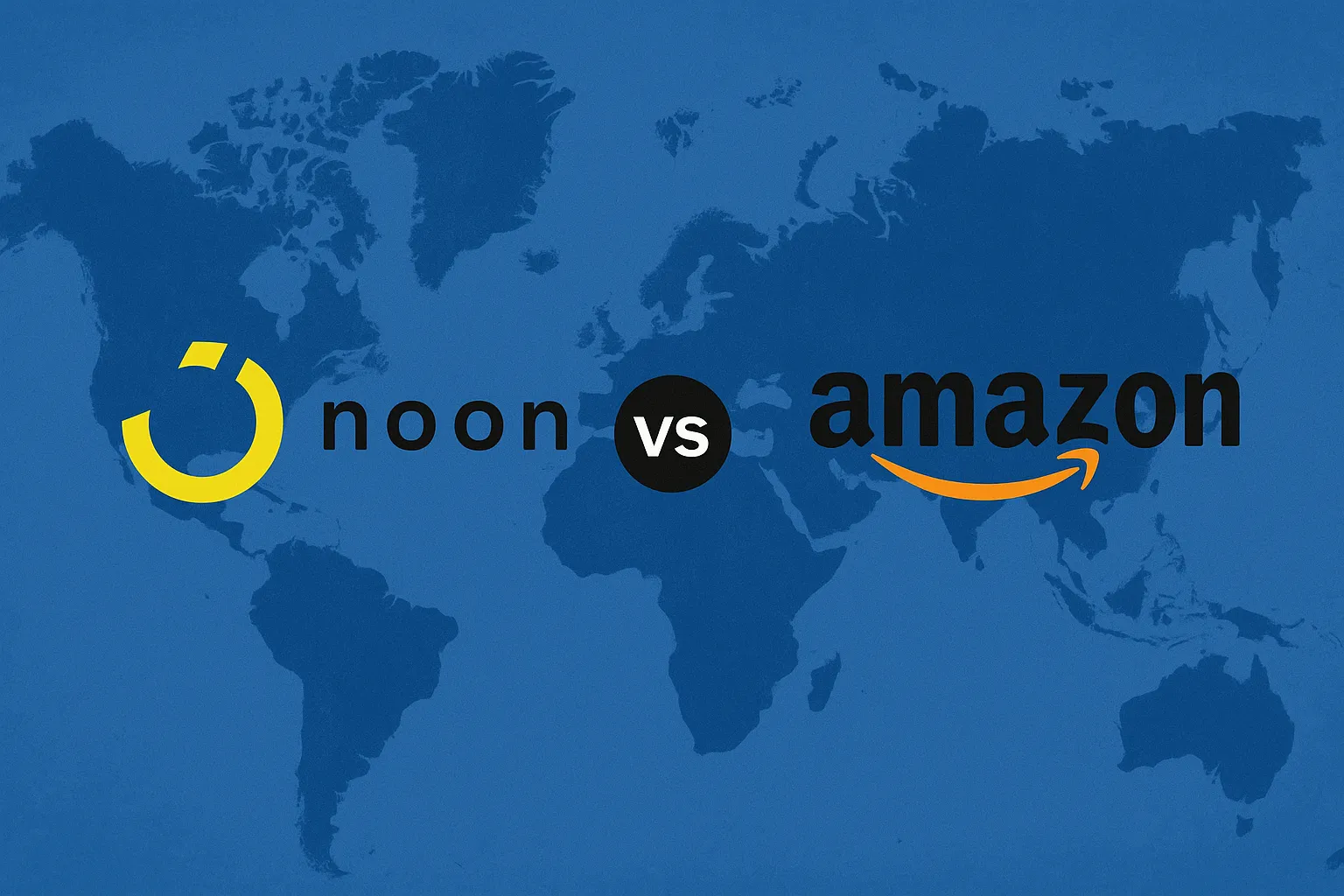In the rapidly evolving world of e-commerce, understanding successful business models is more than just academic—it’s strategic. As we enter 2025, startups and app entrepreneurs are increasingly benchmarking their platforms against two major players: Noon and Amazon.
While both serve millions and dominate the online retail landscape in their respective regions, their approaches to business, logistics, revenue generation, and expansion vary significantly.
So, what makes the Noon business model distinctive in the Middle East and what lessons can be drawn from Amazon’s revenue juggernaut that’s conquered the globe?
Whether you’re launching a marketplace app or scaling your current operations, this blog delivers a detailed, EEAT-compliant comparison between Noon and Amazon to help you make a better-informed decision in 2025.

What is Noon?
Launched in 2017 by Emaar’s Mohamed Alabbar and backed by the Public Investment Fund of Saudi Arabia, Noon is a Middle Eastern e-commerce platform that has quickly gained dominance in UAE, KSA, and Egypt.
It was envisioned as a home-grown answer to global e-commerce giants like Amazon and Alibaba. With categories ranging from fashion to electronics, groceries, and beauty, Noon blends marketplace agility with regional insights.
Key Highlights:
- Regional focus: UAE, Saudi Arabia, Egypt.
- Offers Noon Express (own fulfillment), Noon Food, Noon Grocery, and Noon Pay.
- Targets both B2C and B2B sectors through its seller programs.
What is Amazon?
Amazon, founded by Jeff Bezos in 1994, started as an online bookstore but soon became the largest global e-commerce and cloud services provider. Its customer obsession, extensive logistics, and diversified revenue streams make it a model of innovation.
In the Middle East, Amazon entered via the acquisition of Souq.com in 2017, rebranding to Amazon.ae and Amazon.sa.
Key Highlights:
- Operates in 20+ countries with global logistics dominance.
- Amazon Prime, AWS, FBA (Fulfilled by Amazon), and advertising are top revenue contributors.
- Its business model is a complex blend of marketplace, subscription, cloud computing, and logistics services.
Business Model of Noon
Revenue Streams
- Marketplace Commissions: Takes a % from each sale.
- Noon Express (Private Label): Owns inventory for key items.
- Advertising (Sponsored Products): Monetizes seller listings.
- Noon Pay: Offers fintech services and earns transaction fees.
- Logistics & Fulfillment Fees: Charges for delivery, warehousing, and storage.
Cost Structure
- Warehousing & delivery infrastructure (especially Noon Express)
- Regional marketing & influencer campaigns
- Technology development & maintenance
- Staff salaries (regional teams, logistics workforce)
- Heavy subsidies & discount-based customer acquisition
Key Partnerships
- Public Investment Fund of Saudi Arabia
- Local retailers and small businesses
- Last-mile delivery partners like Aramex and in-house fleet
- Payment gateways & fintech partners
Growth Strategy
- Regional expansion (Egypt, North Africa)
- Diversifying into fintech (Noon Pay)
- Acquisitions & logistics scale-up
- Loyalty programs like Noon One
Learn More: Business Model of Noon : How It Makes Money in E-commerce
Business Model of Amazon
Revenue Streams
- E-commerce Marketplace Commissions
- Fulfilled by Amazon (FBA) Fees
- Subscription Revenue (Prime)
- Amazon Web Services (AWS) – Cloud revenue powerhouse
- Advertising – Now a multi-billion-dollar vertical
- Private Label Products – AmazonBasics, etc.
- Kindle, Audible, and Media Content Sales
Cost Structure
- Global logistics, warehousing, and shipping
- R&D in AI, robotics, drone delivery
- Prime Video content licensing
- Global workforce & automation infrastructure
- Customer service and return logistics
Key Partnerships
- Global sellers & vendors
- Delivery partners (FedEx, DHL, local carriers)
- Cloud clients via AWS
- Affiliates & resellers
Growth Strategy
- International expansion (India, MENA, LATAM)
- Vertical integration (from logistics to hardware)
- Acquisition of companies (Whole Foods, Ring, Zoox)
- Heavy investment in AI & automation
Learn More: Business Model of Amazon in 2025: Revenue Streams & Clone Insights
Comparison Table: Noon vs Amazon
| Feature | Noon | Amazon |
|---|---|---|
| Founded | 2017 | 1994 |
| Headquarters | UAE | USA |
| Business Focus | Regional (MENA) E-commerce | Global E-commerce + Cloud |
| Fulfillment Model | Noon Express + 3P Sellers | FBA + 3P Sellers |
| Tech Ecosystem | Noon Pay, Noon One | AWS, Prime, Alexa, etc. |
| Revenue Streams | Sales Commissions, Logistics | Sales, Prime, AWS, Ads, etc. |
| Logistics Model | In-house fleet + 3P delivery | Fully integrated global network |
| Growth Strategy | Regional scaling + Fintech | Global expansion + AI R&D |
| Advertising | Sponsored listings | Targeted ads + programmatic |
| Subscription Model | Noon One | Amazon Prime |
Pros & Cons of Noon’s Business Model
Pros:
- Localized Strategy: Custom solutions for Middle Eastern buyers.
- Agile Logistics: Noon Express offers quicker, localized delivery.
- Support for Regional SMEs: Empowers small sellers in the region.
- Fintech Expansion: Noon Pay positions it for payment dominance.
Cons:
- Limited Market Reach: Only a few countries covered.
- Heavy Operational Costs: Infrastructure and subsidies eat margins.
- Low Diversification: No cloud or global tech revenue.
Pros & Cons of Amazon’s Business Model
Pros:
- Diverse Revenue Portfolio: AWS, Prime, Ads—all major revenue streams.
- Global Infrastructure: Logistics, tech, and customer service scale.
- Technology-Driven Efficiency: AI, automation, and cloud dominance.
- Powerful Branding & Loyalty: Prime keeps users locked in.
Cons:
- High Burn in New Markets: Entry costs in markets like India & MENA.
- Seller Competition: Private labels compete with 3P sellers.
- Complex Ecosystem: Startups may struggle to emulate the scale.
Market Data: Growth, Revenue, and Funding
Noon (As of 2025)
- Funding: Over $1B raised from PIF and regional investors
- GMV (2024): ~$1.5B across all verticals
- User Base: 40M+ app downloads
- Countries: UAE, KSA, Egypt (80% of revenue)
Amazon (As of 2025)
- Revenue (2024): $610B+
- AWS Revenue: $100B+
- Ad Revenue: $45B+
- Prime Subscribers: 300M+ globally
- Middle East Share: Growing but lags behind Noon in brand loyalty
Which Model is Better for Startups in 2025?
If you’re launching a regional or niche marketplace, the Noon business model offers an easier, more replicable approach. It’s particularly suited for startups focusing on local logistics, fintech integration, and regional sellers.
On the other hand, the Amazon model is ideal for startups with ambitions of global scale, a focus on SaaS, cloud, and tech products, or building multi-service platforms.
Choose Noon-style if…
- You’re targeting a specific region like MENA or South Asia
- You want to own inventory or offer rapid delivery
- Your business involves local partnerships, groceries, or B2C logistics
- You plan to add fintech or loyalty features
Explore our Noon Clone Development solution
Choose Amazon-style if…
- You aim to build a global platform or SaaS-commerce hybrid
- You want scalable infrastructure like FBA
- You’re integrating subscriptions, advertising, or cloud-based services
- You’re entering tech-enabled verticals like IoT, AI, or automation
Explore our Amazon Clone Development solution
Conclusion
Both Noon and Amazon offer powerful yet distinct paths to e-commerce success. Noon is ideal for regional growth and fintech integration, while Amazon excels in global scale and diversified revenue.
Understanding these models gives you an edge in 2025—and with Miracuves, you can turn that insight into action. We help startups build custom solutions inspired by industry leaders.
FAQs
What is the key difference between Noon and Amazon?
Noon focuses on regional e-commerce in MENA, while Amazon is a global platform with diversified tech services.
Is Noon profitable?
Not yet, but it’s scaling aggressively in key MENA markets and investing heavily in logistics and fintech.
Can I build an app like Noon or Amazon?
Yes! Miracuves offers ready-to-deploy clone solutions for both Noon and Amazon with full customization and scalability.
Which is better for small businesses?
Noon provides more regional visibility and support for SMEs, while Amazon has broader reach and infrastructure.
Does Amazon still own Souq?
No. Souq.com was rebranded to Amazon.ae and Amazon.sa after Amazon’s acquisition.








